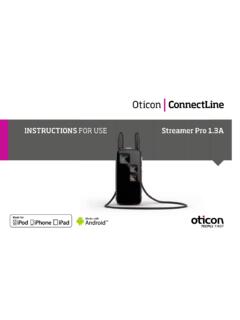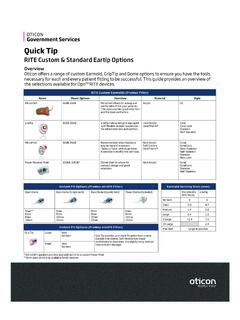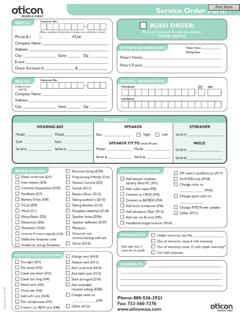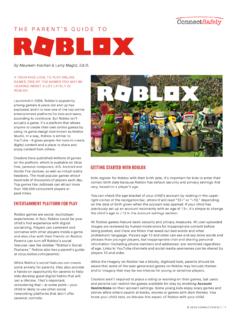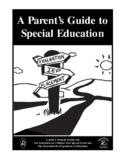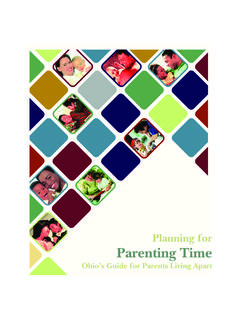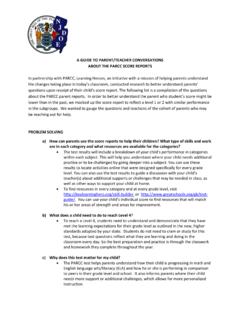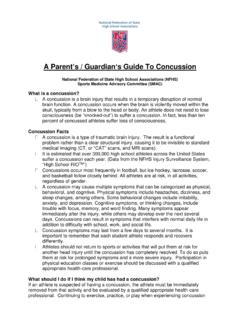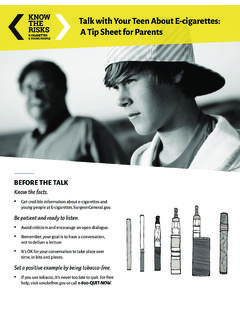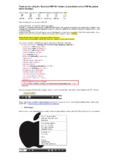Transcription of Parents’ Guide - Oticon
1 parents GuideA Guide for parents of children with hearing lossHearing is one of the things many of us take for granted. It plays an enormous role in our lives. Yet, as long as it works we tend to forget that it is birth we develop language by dis-tinguishing between meaningful speech sounds and environmental noise. A hearing loss reduces these skills. Fortunately we know more about hearing loss than ever before and a lot can be done to help. This booklet should help you under-stand your child s hearing loss. It tells you how the ear works. It tells you about the most common types of hearing loss and how hearing instruments can help. It also explains the communication tech-niques that you can use to make every-day life easier for both you and your more information you can also visit Purpose of this BookletTable of Contents| What Causes Hearing Loss | Understanding Hearing Loss| Accepting Your Child s Hearing Loss | Why Hearing is so Important | The Benefits of Hearing instruments | Types of Hearing instruments and Listening Devices | Helping Your Child Communicate | Good Tips on Raising a Child with Hearing Loss | Making Everyday Life Easier | Frequently Asked Questions| Glossary 511171921253337414446abcgfde36215454 How the ear worksThe ear is made up of three main sections: the outer ear the middle ear the inner earWhat Causes Hearing Loss1.
2 Outer Ear2. Middle Ear3. Inner EarThe two main parts of the outer ear are the pinna (a) and the ear canal (b). Sound waves enter the ear canal and travel towards the eardrum (c). When the sound reaches the eardrum, it vibrates - just like a real drum does when you hit give you some insight into what causes a hearing loss this chapter begins by telling you a little about how the ear works. It also describes the different kinds of hearing loss, and the effects of a hearing loss. 4. Conductive Portion 5. Sensorineural Portion6. Auditory NerveThe sound vibrations make this fluid move, and thousands of tiny hair cells are set in motion. They transform the vibrations into electrical impulses, which travel along the auditory nerve to the brain. The brain interprets these signals, and that is how we hear. The different types of hearing lossIn general, there are two main types of hearing loss:Conductive hearing lossThis is caused by problems in the outer and/or middle ear, that can stop sounds getting through to the inner ear.
3 In children, this is mostly due to middle ear infections, or a build-up of fluid in the middle ear. But conductive hearing loss can also be caused by wax, a hole in the eardrum, or by the tiny bones inside the ear being dam-aged or their movements being percent of all children between 0-6 years of age get middle ear infec-tions at least once in their lives. Most infections heal without causing any lasting damage. Sometimes middle ear infections can cause temporary hearing loss, which can delay the child s language and speech develop-ment. If the infections last a long time, the middle ear can be damaged, which can result in permanent hearing hearing loss This happens when some of the delicate hair cells in the inner ear break down, and are unable to convert sound waves into electrical signals. Sometimes the nerve pathways in the auditory nerve are damaged, which also prevents the signals from reach-ing the brain.
4 This kind of hearing loss can also be caused by excessive noise from machinery, or loud hearing loss is some-times passed down from parent to child. But this is really difficult to predict, because more than half of children with hereditary hearing loss have parents with no history of hear-ing loss. In their case it could still be a genetic problem that might have skipped several these vibrations reach the middle ear, three tiny bones called the ossicles (also known as the hammer (d), anvil (e) and stirrup (f)) begin to vibrate. They amplify the sound even the sound waves reach the inner ear, they enter the cochlea (g). This looks like the circular shell of a snail. Inside, there is a system of tubes filled with causes of hearing lossMany things can cause hearing loss: Certain infections during pregnancy - such as German measles (rubella) Complications during birth such as premature birth or lack of oxygen Hereditary, genetic factors Middle ear infections Infections such as meningitis, mumps, measles, or whooping cough Very loud noise, such as fireworks, loud music, or machinery Trauma, such as head injuries In some cases it s very hard to pin-point the cause.
5 Although doctors might list the cause as unknown , it can still be related to one of the above can be described as loud or soft, and high-pitched or low-pitched. A violin, or birds chirping are exam-ples of high-pitched (or high frequen-cy) sounds - while a tuba, or traffic in the street are examples of low-pitched (or low frequency) audiologist can perform a hearing test on your child. There are several types of measurement methods. Your child s age and ability to cooperate will determine which methods the audiologist chooses to use. Performing a hearing test, especially on smaller children, may take some time. In order to keep the child engaged and limit boredom, a hearing test may be bro-ken up into several visits. Often more tests are required in order to define the degree of hearing the Hearing LossThe audiologist measures the sound level at which your child can or cannot hear different tones.
6 The results are then plotted on a chart, an audiogram. The audiogram shows whether your child actually has a hearing loss, and if so, what kind it is, and how severe it is. This helps the experts decide what treatment is best. As a parent your involvement is chapter shows you how valuable a hearing test is, in terms of what it can tell you about your child s hearing. It shows you the kind of sounds your child can hear when not wearing hearing instruments, and explains the effect of varying degrees of hearing loss. 1312 Generally, the degree of hearing loss is described using one of five categories: Mild hearing loss (average from 15-40 dB HL) Moderate hearing loss (average from 40-55 dB HL) Moderate/Severe hearing loss (average from 55-70 dB HL) Severe hearing loss (average from 70-90 dB HL) Profound hearing loss (average above 90 dB HL)The audiogramWhen you learn to read the audiogram it will help you understand which sounds you can expect your child to hear, without amplification.
7 The O indicates the hearing level on the right ear. The X indicates the hearing level on the left ear. The audiogram on the right shows a mild to moderate/severe hearing loss sloping from low to high Hearing LossSevere Hearing LossModerate/Severe Hearing LossModerate Hearing LossNormal Hearing SensitivityMild Hearing LossAs you can see from this graphic, a child with normal hearing can hear sounds within the 0-15 dB HL out what your child can hearAs an experiment, take your son s or daughter s audiogram and copy the line onto the graph on page 15. This graph shows where certain sounds are on the sound map, and will give you a good idea of the sounds your child can hear when not wearing hearing high-pitched sounds are at the right of 1000 Hz on the chart, and the low-pitched sounds are at the left of 1000 Hz. The shaded area is called the speech spectrum.
8 It shows you the levels you need to be able to hear in order to understand what people are saying when they are talking normally (not too soft/not too loud).This audiogram shows: That with mild to moderate hearing loss (15-55 dB HL) it is difficult to understand most speech, even in good listening conditions (no back- ground noise). That with moderate to severe hearing loss (55-70 dB HL), speech has to be very loud to be understood. That with profound hearing loss (above 90 dB HL), communicating can be very difficult even with hearing instruments. In this case it might help to use specific communi- cation your son or daughter s audiogram and copy the line onto this (Hz)LoudSoftLoudness (db HL)0102030405060708090100110120 125 250 500 1000 2000 4000 80001716 The idea of your child s hearing loss may have left you feeling shocked and numb, or sad and worried about the future.
9 It may be hard for you to accept what the doctors are saying. You may be thinking Why us? because you never expected something like this to happen. This is a perfectly understand-able takes time to understand and accept the fact that your child has a hearing loss. As soon as you are able to do this, you can begin to focus on how to cope with it. And when you re ready, you can gather more information that will help you deal with the practical side of you cope depends upon the kind of person you are. Certainly the best way to handle it is by being open, and by letting other people help you. As time passes, and circumstances change, new situations will arise. And when they do, the easiest way to cope is by taking things one step at a time. If you need advice don t hesitate to ask your child's audiologists, teachers, hearing care professionals or other parents of children with hearing loss.
10 They know a lot about your your son or daughter to talk about the way they feel - not only with you, but also with other children with hearing loss. They have a unique understanding of the that you are not alone. Hearing loss is more common than you think. In the US approximately 30 mil-lion people have hearing loss. And about one million of them are children below age Your Child s Hearing LossBefore you knew for sure that your son or daughter had a hearing loss you probably felt very insecure. This chapter helps you deal with the emotional aspects of coping with your child s hearing languageWe start to develop language from the moment we are born. At first, babies only make crying, sneezing, yawning, and coughing sounds. Even though they haven t yet learned to talk, they are constantly listening. A newborn baby can soon recognize its mother s voice.



